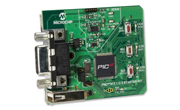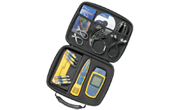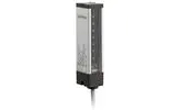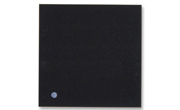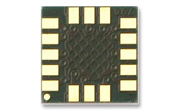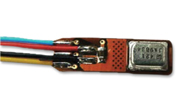How to design a MEMS vibration sensor for predictive maintenance
In the past, checking for problems and expert analysis took a lot of time and made maintenance expensive.
Modern sensors have transformed predictive maintenance by offering real-time monitoring and early fault detection, which is crucial for large-scale operations. These sensors work seamlessly with Computerized Maintenance Management Systems (CMMS), providing high accuracy, reliability, and robust real-time data processing.
To be effective, sensors must be durable under harsh conditions and have low power consumption. Key parameters for analyzing machine vibrations include output speed, turbulence, cavitation, and bearing elements. Proper sensor orientation is important. Single-axis sensors align with linear vibrations, while multi axis sensors detect vibrations in all directions but may have higher noise levels. This article explains the essential features sensors need for predictive maintenance in industrial environments.
Factors to be considered when designing sensors for predictive maintenance
Several critical factors must be considered when designing sensors for predictive maintenance to ensure their effectiveness and reliability.
- High accuracy and reliability: Sensors must detect early signs of equipment failure with high accuracy and reliability.
- Robust data processing and integration: Robust real-time data processing capabilities are essential. Sensors should integrate seamlessly with existing maintenance systems to provide actionable insights.
- Durability and low power consumption: Durability in harsh conditions and low power consumption are also crucial for sustained operation.
Wide frequency response
A wide frequency response is essential for vibration sensors used in predictive maintenance. This allows the detection of a broad spectrum of vibration frequencies, which is vital for identifying various equipment faults. The key points include:
By addressing these factors, sensors can significantly enhance maintenance processes, improve efficiency, and ensure safety in large-scale operations.
Measurement resolution and dynamic range
The measurement resolution of a vibration sensor depends on the amplitude of the output relative to the broadband noise of its onboard electronics. Sensors with superior signal output can detect more minor vibration levels in machinery, enabling earlier fault prediction compared to sensors with lower dynamic ranges. Environmental conditions, EMI/RFI interference, Data acquisition interface quality, and cable length influence measurement resolution and should be carefully considered during installation. To ensure reliable measurements, the output signal should be at least ten times higher than the sensor's noise level. This can be calculated using the following equation:
RESOLUTION (g’s) = BROADBAND NOISE (V) / SENSOR SENSITIVITY (V/g) --- Eq 1
Long-term stability with minimum drift
Long-term drift refers to changes in a sensor’s sensitivity and zero output measurements. Zero output drift is particularly relevant for MEMS sensors. Shifts in sensitivity or zero output can cause false alarms in monitoring applications. Stability is crucial for reliable monitoring, providing accurate data to detect subtle changes in vibration patterns that could indicate potential faults. Minimal drift reduces the need for frequent recalibration, lowering maintenance costs and minimizing downtime.
Low noise
Low noise is essential for enhancing measurement accuracy and data reliability. Low-noise sensors minimize electrical and environmental interference, allowing for precise detection of subtle vibrations and early signs of equipment faults. This clarity improves the sensor's ability to distinguish between normal operational vibrations and potential issues, reducing the likelihood of false alarms and unnecessary maintenance actions. High-quality, low-noise data supports accurate predictive modelling and effective maintenance decisions, ensuring the sensor remains reliable and efficient.
Operating temperature range
The typical operating temperature of piezoelectric sensors is within -500C to 2000 °C, and Variable Capacitance MEMS vibration sensors typically operate within a temperature range of -40°C to +125°C, which is suitable for condition monitoring applications. However, charge mode piezoelectric sensors without onboard charge converter circuits are recommended for extreme requirements requiring higher temperature tolerance (exceeding +700°C). Piezoelectric sensors offer higher temperature limits with specialized materials, and variable capacitance sensors provide stability across a wide range of temperatures, making them versatile in various industrial and scientific applications.
Packaging options
Sensors' size and mounting options are crucial when selecting a sensor for embedded predictive maintenance, especially for smaller machinery. While larger machinery often uses externally mounted TO-5 stud sensors, smaller machinery with compact bearings and shafts requires embedded or miniature sensors.
Variable Capacitance MEMS sensors are commonly available in SMT mount packages, which are ideal for high-volume PCB assembly. These sensors also come in tiny packages, offering flexibility in packaging options.
Piezoelectric (PE) sensors come in various configurations. SMT mount versions are available, like Variable Capacitance MEMS, although they are typically larger. Additionally, PE sensors are offered in rugged TO-5 can packages with stainless-steel housings, allowing direct mounting to bearing housings or embedded installations.
Sensor output options
Selecting the right sensor output signal depends on the installation and application requirements. In most current predictive maintenance setups, an analog signal from the sensor is essential, allowing end users to monitor specific machinery parameters. The signal output, commonly driven by DAQ or PLC interfaces, typically uses analog outputs such as ±2V or ±5V. Alternatively, loop-powered 4-20mA sensors are frequently employed for installations needing long cable lengths.
Predictive maintenance (PdM) systems require high-performance sensors to ensure reliable asset operation. The performance of these sensors is linked to the importance of the asset rather than its cost. Motor vibration analysis (measuring peak, peak-to-peak, RMS) can detect issues like imbalance or misalignment. However, early-stage faults like bearing or gear defects need high-performance vibration sensors. These sensors should have low noise (<100 µg/√Hz) and wide bandwidth (>5 kHz) to detect these faults effectively. They must also be used with a high-performance signal chain, processing, transceivers, and post-processing systems.
AI-driven anomaly detection for industrial HVAC systems

Figure 1: XENSIV™ PdM Evaluation Kit (Source)
Industrial HVAC systems are essential for maintaining comfortable and climate-controlled environments in office buildings, industrial facilities, and commercial living spaces. However, the complexity of modern equipment and compatibility issues with legacy systems can lead to costly failures and downtime, disrupting business operations and tenant satisfaction.
To address these challenges, Infineon, in collaboration with Klika Tech and AWS, has developed an advanced solution that leverages AI and TinyML at the edge. This solution integrates Infineon’s high-precision XENSIV™ sensors, XMC™ microcontrollers, and OPTIGA™ Trust security solutions to monitor HVAC system performance in real time.
Working: The system continuously monitors HVAC systems using Infineon’s XENSIV™ sensors, which collect real-time data. This data is processed by a TinyML model that immediately detects any anomalies, identifying potential issues as they occur. When an anomaly is detected, the system compiles the relevant sensor data and transmits it to a cloud-based AI solution. The AI then analyzes the data, generating actionable insights and potential solutions. These insights empower businesses to proactively manage and address issues, effectively minimizing downtime and preventing costly failures.
Key benefits:
- Preventative maintenance: By identifying issues early, the system helps prevent unexpected failures, reducing the risk of operational disruptions.
- Enhanced system performance: Continuous monitoring ensures HVAC systems operate efficiently, maintaining optimal environmental conditions.
- Seamless integration: The solution is designed to work with both modern and legacy HVAC systems, providing a versatile and robust approach to anomaly detection.
Conclusion
Modern predictive maintenance relies on advanced sensors to provide real-time monitoring and early fault detection, enhancing efficiency and safety in industrial operations. Key factors for effective sensors include wide frequency response, high measurement resolution, minimal long-term drift, and robust performance in harsh conditions. MEMS-based accelerometers are particularly advantageous due to their high resolution, low power consumption, and integration capabilities. These advancements in sensor technology streamline maintenance processes and improve operational reliability.
Stay informed
Keep up to date on the latest information and exclusive offers!
Subscribe now
Thanks for subscribing
Well done! You are now part of an elite group who receive the latest info on products, technologies and applications straight to your inbox.
Read more on:
Whitepaper: Smart maintenance: The Evolution of Predictive Maintenance (PdM)
Predictive maintenance to reduce energy waste
Transformation of traditional maintenance to predictive maintenance
Choosing the most suitable Predictive Maintenance Sensor for Industry 4.0
Related Articles
- Advanced ML for MEMS Sensors: Enhancing the Accuracy, Performance, and Power consumption
- How to design a MEMS Vibration Sensor for predictive maintenance
- Precision in Sight: How AI-powered visual inspection improves industrial quality control
- How to Capture High-Quality, Undistorted Images for Industrial Machine Vision
- Robotics and AI Integration: Transforming Industrial Automation
- The modern challenges of facial recognition
- Intelligent cameras for smart security and elevated surveillance
- Evolution of voice, speech, and sound recognition
- AI and IoT: The future of intelligent transportation systems
- Machine Vision Sensors: How Machines View the World
- Demystifying AI and ML with embedded devices
- How to implement convolutional neural network on STM32 and Arduino
- How to do image classification using ADI MAX78000
- The Benefits of Using Sensors and AI in HVAC Systems
- Deep learning and neural networks
- Latest Trends in Artificial Intelligence
- Hello world for Machine Learning
- How to implement AR in process control application

